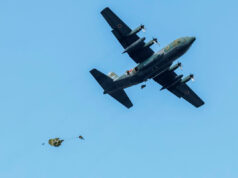This is a UK first for the integration of a UAV into a helicopter’s mission system – allowing a helicopter crew to control a UAV from the cockpit as if it was one of the aircraft’s on-board sensors.
Leonardo successfully demonstrated unique integrated capabilities between a manned aircraft and an unmanned aerial vehicle (UAV).
This took place in the UK during Manned-Unmanned Teaming (MUMT) trials between a Leonardo AW159 Wildcat helicopter and a semi-autonomous UAV from Callen-Lenz Associates.
“In this instance, MUMT is when a helicopter crew controls a UAV from the helicopter like it was an onboard sensor being controlled from the cockpit. By integrating control of the UAV into the Wildcat Mission System, Leonardo was able to minimise the pilots’ workload allowing them to focus more on the mission whilst simultaneously controlling the UAV – this is the first time such an integrated capability has been demonstrated in the UK on a military aircraft. A ‘Gateway Processor’ supplied by Callen-Lenz Associates was used to interface with its semi-autonomous UAV.
The Leonardo solution allows the Wildcat crew to control both the flight path and payload of the UAV (a capability known as Level of Interoperability (LOI) 4) using an efficient and effective task based Human Machine Interface (HMI), rather than the more operator intensive approaches employed on other systems.
Combining the strengths of manned and unmanned platforms, MUMT has the potential to play a transformative role by increasing the situational awareness, tempo, lethality, survivability and combat mass of aviation forces, significantly reducing crew workload allowing pilots to focus on the mission at hand. Teaming of manned aircraft with unmanned air systems (Manned Unmanned Teaming MUMT) enhances air support capability in both the Land and Maritime environments. It also enables extended and complex operations to be conducted with a mix of platforms and systems.”
The demonstration was part of the British Army’s MUMT themed Army Warfighting Experiment (AWE) 19, and was planned and executed by Dstl and took place on Salisbury Plain in September.
Nick Whitney, Managing Director of Leonardo Helicopters (UK), said:
“The success of this manned-unmanned trial highlights that Leonardo and the UK MoD are investing together in the future of UK rotorcraft engineering and it demonstrates further the value of a long-term partnering approach in terms of capability development.”
Bryan Finlay, Technical Partner at Defence Science and Technology Laboratory (Dstl), stated:
“Leonardo and Callen-Lenz have delivered a fantastic demonstration of the integration of a UAV control station into the mission management system of the Wildcat helicopter. The clever design of the human machine interface means that cockpit workload is well managed and the demonstration has successfully de-risked that technology. This is a key step towards realising an effective operational MUMT capability.”













That’s pretty cool!
If I read it right, this is the kind of capability that they’re looking at for the AH-64Es too. I’m pretty sure I read that they would be able to control drones. Using targetting data from a forward-ranging drone that you’re able to simply operate like an on-board sensor is a bit like a longbow mast multiplied.
I can see advantages for ASW work too, if they can get a large enough UAV to carry dipping sonar or the magnetic sensors.
Even as-is, anti-piracy and SAR operations would be made a lot easier, I can see these being used in the Gulf.
Looks like Callen-Lenz are using Blue Bear Redkite as the UAV platform for those that often ask why UK companies aren’t producing drones.
https://bbsr.co.uk/wp-content/uploads/2018/09/redkite.pdf
Yes, I noticed that, both British companies which is great! Unfortunately neither seem to be in the market of the larger sized drones currently- the kind of stuff that could feasibly be called a loyal wingman or similar. Hopefully they might be able to scale up, with a bit of investment.
Agreed Joe, and with Tempest coming along the loyal wingman will be integral to the concept, but the top of my personal wish list right now when it comes to wishing that UK companies could go larger is something with similar payload and endurance characteristics as the Schiebel S-100 Camcopter, or even 25% – 50% greater if new technology allowed that to be done and still keep it small enough to be stores and maintained in a standard 20′ ISO container for embarking on things like River Batch 2. That could transform the capabilities of those vessels in certain roles and for simple surveillance tasks also save flight hours on crewed helicopters even on ships that are capable of hosting Merlin and Wildcat. If a UK company was able to create a truly world-class offering in that sort of size/weight category it would also have enormous export potential.
A loyal wingman, I think, will be a lot more marketable because there will likely be fewer competitors and it’s an inherently more high-end product (think the success we’ve had with T26).
You make a fair point though, there would be a lot of potential for this kind of smaller UAV- although unfortunately it’s also a crowded marketplace. I’m confident that it’s possible, and not everyone is willing to pick up Israeli systems for political reasons (they seem to be one of the big players in this bracket). It would also be a great stepping stone to the loyal wingman concept in terms of the autonomous cooperative programming and all of that stuff.
River OPVs with rotary-wing UAVs would make perfect sense for all kinds of tasks close to home and in the Med (from the Gib-based vessel), as well as from T31s in the Straits of Hormuz etc. Am I right in thinking that we have another River B2 permanently based in the Caribbean too? It’d be a good solution for drugs interdiction too, potentially, although I do think that they need a larger vessel out there for assistance with disaster relief.
Fair point re high end a less crowded marketplace Joe. I guess we’re probably in agreement that it would be good if UK industry could have a strong offering for drone classes.
On the crowded mid-range marketplace I was assuming the UK could differentiate on capability, it would far less interesting if we ended up with essentially a Schiebel S-100 clone with similar specifications.
Aha no that is definitely not a Red Kite. Besides, the Red Kite isn’t really ‘produced’ in the uk, it is a rebadged Penguin from UAV Factory in Latvia..
This is the kind of thing that is going to make the Type 31s lethal.
i cant see the advantages of a wildcat controlling a drone rather than a ground/ship based operator doing it. There are advantages in using a drone instead of a wildcat especially in the area of sonobuoy monitoring where it could be used to data link raw buoy data back to the mothership, leaving the wildcat at alert ready to deploy with torpedoes. The drone could even be used to deploy sonobuoys. i doubt we will ever see a drone carrying a couple of 600lb torpedoes. !!
How are these drones deployed and recovered for reuse?
‘I know nothing’ as the great waiter used to say but one presumes this offers a direct line of flight link whereas otherwise it would if operated from a ship have to go over a satellite? Especially if you want to operate far from the ship over the horizon. Perhaps others can be more illuminating.
That is an Army Lynx (no radar under nose) and article states it was part of an Army War-fighting Experiment….
you are quite right dave g, I should have noticed that especially considering my handle. A drone could certainly enhace the effectiveness of an Apache, and the E upgrade provided for UAV control. Im not sure about the Wildcat though, is it capable of firng helfires blind? In fact im not clear about the Wildcat’s role on the battlefield.
From the army website: reconnaissance, command and control, transportation of troops and material, and the provision of force protection (where you don’t need an apache).
It will also work with the apache.
https://www.army.mod.uk/news-and-events/news/2018/06/wildcat-helicopter-works-alongside-apache/
The last paragraph of the article shows that the focus of this activity was to demonstrate and derisk the integration of the manned and unmanned team rather than being a final solution. Once you can get them working together there are options for how you do it from taking control of an independent drone when needed, working with a separately launched system as shown above, to something similar to what the US army “air Launched Effects” programme and altius drone are working towards.
Shame the UK will not fund the Uk’s Gem-7 long-endurance UAV. The military and government technology grant systems have declined to assist.
http://www.gem-aero.uk
R
What can this do the others cannot?